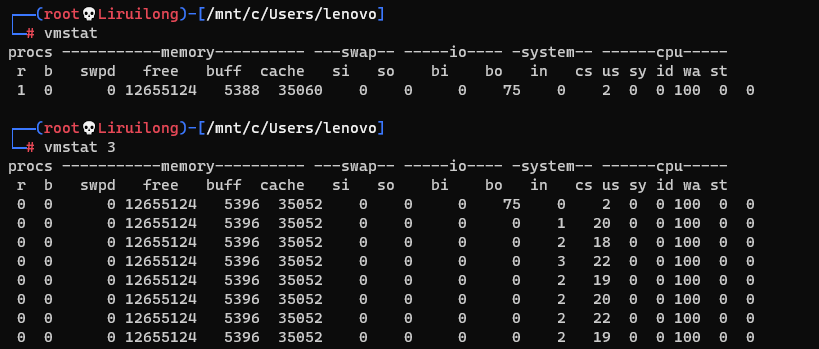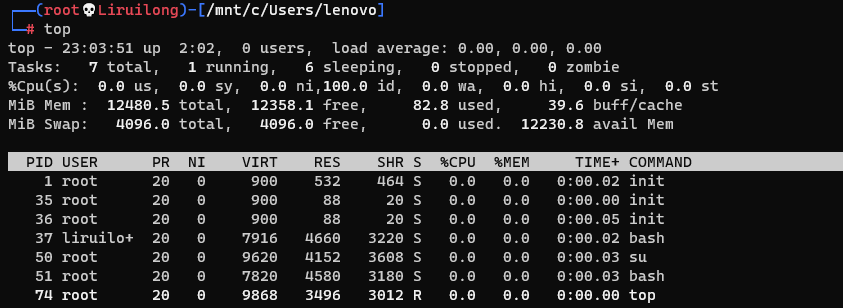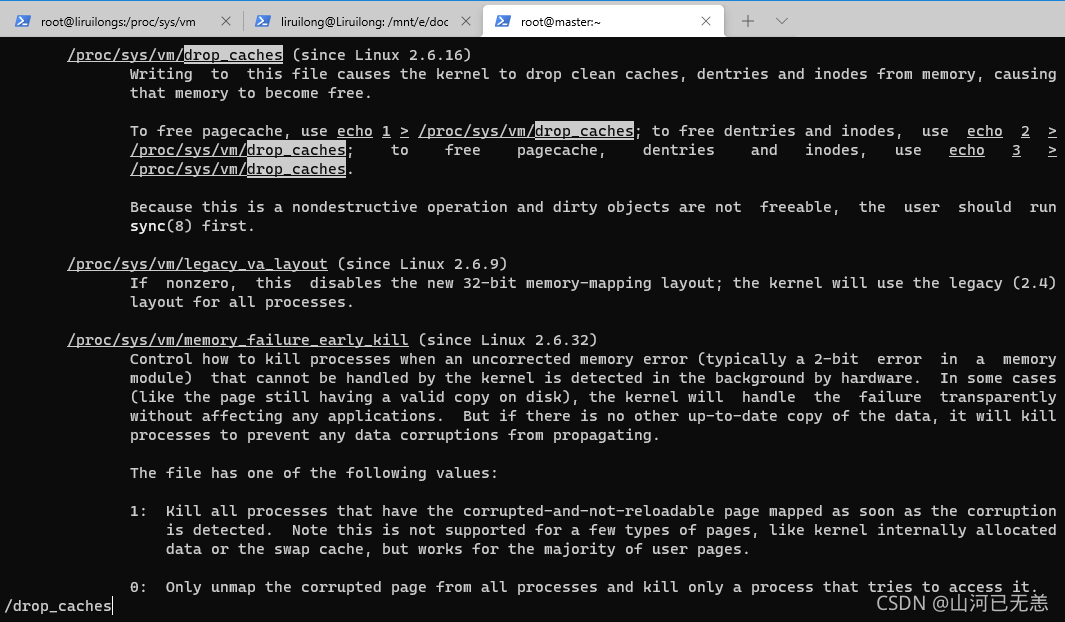写在前面
嗯,关于缓存清理,小伙伴一定不陌生,个人觉得通过修改drop_caches内核参数的形式来清理缓存,只能是在生产环境用于临时解决问题,本质还是要对应用进行分析,看看是什么原因导致的内存溢出等 OOM 问题,一般情况下,内存溢出可以通过交换分区来确定
当然,如果是因为业务量的原因,业务高峰,或者需要算力等正常原因,可以定期通过sync将缓存区没有写入数据写入磁盘,然后修改内核参数 drop_caches的值来清理缓存,或者通过新建交换分区调整swappiness交换分区频率来解决问题,如果虚机的话可以申请扩内存
系统内存查看
其中: Mem:实际的内存
total 内存总数
used 已经使用的内存数
free 空闲的内存数
shared 多个进程共享的内存总额
buff/Cache 缓存的内存大小
available 可用内存
Swap: 交换分区
系统内存监控
vmstat: 是一个内存监控工具,后面的数字为刷新频率
vmstat 列描述
free:空闲的物理内存的大小。
buff:Linux/Unix 系统是用来存储,目录里面有什么内容,权限等的缓存.
cache: cache 直接用来记忆我们打开的文件,给文件做缓冲,我本机大概占用 300 多 M(这里是 Linux/Unix 的聪明之处,把空闲的物理内存的一部分拿来做文件和目录的缓存,是为了提高 程序执行的性能,当程序使用内存时,buffer/cached 会很快地被使用。)
top 不多说
修改 drop_caches 内核参数清理缓存
我们先看看帮助文档:内核参数的帮助文档查看方式
┌──[root@liruilongs.github.io]-[/proc/sys/vm]└─$ man -K drop_caches--Man-- next: proc(5) [ view (return) | skip (Ctrl-D) | quit (Ctrl-C) ]
复制代码
嗯,英文好的小伙伴可以看看
drop_caches
Writing to this will cause the kernel to drop clean caches, as well asreclaimable slab objects like dentries and inodes. Once dropped, theirmemory becomes free.
To free pagecache: echo 1 > /proc/sys/vm/drop_cachesTo free reclaimable slab objects (includes dentries and inodes): echo 2 > /proc/sys/vm/drop_cachesTo free slab objects and pagecache: echo 3 > /proc/sys/vm/drop_caches
This is a non-destructive operation and will not free any dirty objects.To increase the number of objects freed by this operation, the user may run`sync' prior to writing to /proc/sys/vm/drop_caches. This will minimize thenumber of dirty objects on the system and create more candidates to bedropped.
This file is not a means to control the growth of the various kernel caches(inodes, dentries, pagecache, etc...) These objects are automaticallyreclaimed by the kernel when memory is needed elsewhere on the system.
Use of this file can cause performance problems. Since it discards cachedobjects, it may cost a significant amount of I/O and CPU to recreate thedropped objects, especially if they were under heavy use. Because of this,use outside of a testing or debugging environment is not recommended.
You may see informational messages in your kernel log when this file isused:
cat (1234): drop_caches: 3
These are informational only. They do not mean that anything is wrongwith your system. To disable them, echo 4 (bit 2) into drop_caches.
复制代码
手动执行 sync 命令(描述:sync 命令运行 sync 子例程。如果必须停止系统,则运行 sync 命令以确保文件系统的完整性。sync 命令将所有未写的系统缓冲区写到磁盘中,包含已修改的 i-node、已延迟的块 I/O 和读写映射文件)
┌──(root💀Liruilong)-[/mnt/c/Users/lenovo]└─# sync
复制代码
对缓存进行清理
┌──(root💀Liruilong)-[/mnt/c/Users/lenovo]└─# free -m total used free shared buff/cache availableMem: 12480 84 12355 0 40 12228Swap: 4096 0 4096
┌──(root💀Liruilong)-[/mnt/c/Users/lenovo]└─# echo 3 > /proc/sys/vm/drop_caches
┌──(root💀Liruilong)-[/mnt/c/Users/lenovo]└─# free -m total used free shared buff/cache availableMem: 12480 84 12372 0 23 12237Swap: 4096 0 4096
复制代码
我们来看看文档
写入drop_caches将导致内核丢弃干净的缓存,以及可回收的 slab 对象,如 dentry 和 inode。一旦下降,他们内存得到释放。
具体的参数描述
To free pagecache: echo 1 > /proc/sys/vm/drop_cachesTo free reclaimable slab objects (includes dentries and inodes): echo 2 > /proc/sys/vm/drop_cachesTo free slab objects and pagecache: echo 3 > /proc/sys/vm/drop_caches
复制代码
使用此文件可能会导致性能问题。因为它丢弃了缓存对象,它可能会花费大量的 I/O 和 CPU 来重新创建掉落的物体,特别是大量使用时。由于这个原因,不建议在测试或调试环境之外使用。
在内核的文档里也说不建议在测试或调试环境之外使用,重建一些需要的缓存还是会消耗大量的 I/O 和 CPU,同时这也不是一个必要操作,一些不用的缓存系统会自动的清理掉
一个 SHELL
最后在和小伙伴分享一个清理缓存的 shell
#!/bin/bash
#@File : clear.sh#@Time : 2021/12/27 23:52:20#@Author : Li Ruilong#@Version : 1.0#@Desc : 清除缓存的shell#@Contact : 1224965096@qq.com
max=10000 # 缓存的最大值
clearLog=/var/log/clearfreelogif [ ! -f $clearLog ];then touch $clearLogfi
filesize=$(du -m $clearLog | awk '{ print $1 }')echo "filesize=$filesize"if [ $filesize -gt 300 ]; thenecho $clearLog > $clearLogfi
cache=$( free -m | grep Mem | awk '{print $(NF-1)}')
time=$(date)
if [ $cache -gt $max ]then echo "$time cache=$cache flush cache start!" >> $clearLog sync echo 3 > /proc/sys/vm/drop_caches echo "$time FreeMemory Success!" >> $clearLogelse echo "$time cache=$cache Memory is normal" >> $clearLogfi
复制代码



















评论